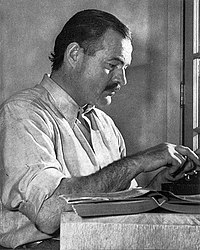
For Whom the Bell Tolls is a novel by Ernest Hemingway published in 1940. It tells the story of Robert Jordan, a young American in the International Brigades attached to a republican guerrilla unit during the Spanish Civil War. As a dynamiter, he is assigned to blow up a bridge during an attack on the city of Segovia. Hemingway biographer Jeffrey Meyers writes that the novel is regarded as one of Hemingway's best works, along with The Sun Also Rises, The Old Man and the Sea, and A Farewell to Arms.
For Whom the Bell Tolls (1940) takes place during the Spanish Civil War, which ravaged the country throughout the late 1930s. Tensions in Spain began to rise as early as 1931, when a group of left-wing Republicans overthrew the country’s monarchy in a bloodless coup. The new Republican government then proposed controversial religious reforms that angered right-wing Fascists, who had the support of the army and the Catholic church.
After a strong Communist turnout in the 1936 popular elections, the Fascist army commander Generalísimo Francisco Franco initiated a coup in an attempt to overthrow the Republican government. Unexpectedly, the key cities of Madrid and Barcelona remained loyal to the Republic. This divide marked the beginning of the Spanish Civil War, a conflict between the right-wing Fascists (Nationalists) and the left-wing Republicans (Loyalists), a large number of whom were Communists. Violence exploded all over Spain, and both sides committed atrocities. Many western countries saw the Spanish Civil War as a symbolic struggle between fascism and democracy. Eventually, the superior military machine of the Fascist alliance prevailed, and the war ended in the spring of 1939.
During the Spanish Civil War, Hemingway was involved in the production of two Loyalist propaganda documentary films. Later in the conflict, he served as a war correspondent for the North American Newspaper Alliance. For Whom the Bell Tolls expresses Hemingway’s strong feelings about the war, both a critique of the Republicans’ leadership and a lament over the Fascists’ destruction of the earthy way of life of the Spanish peasantry. The novel is set in the spring of 1937, at a time when the war had come to a standstill, a month after German troops razed the Spanish town of Guernica. At this point, the Republicans still held out some hope for victory and were planning a new offensive. For Whom the Bell Tolls explores themes of wartime individuality, the effects of war on its combatants, and the military bureaucracy’s impersonal indifference to human life. Most important, the novel addresses the question of whether an idealistic view of the world justifies violence.
Hemingway’s novels are known for portraying a particular type of hero. Critic Philip Young famously termed this figure a “code hero,” a man who gracefully struggles against death and obliteration. Robert Jordan, the protagonist of For Whom the Bell Tolls, is a prime example of this kind of hero. The tragedy of the code hero is that he is mortal and knows that he will ultimately lose the struggle. Meanwhile, he lives according to a code—hence the term code hero—that helps him endure a life full of stress and tension with courage and grace. He appreciates the physical pleasures of this world—food, drink, sex, and so on—without obsessing over them.
Hemingway is particularly known for his journalistic prose style, which was revolutionary at the time and has influenced countless writers since. Hemingway’s writing is succinct and direct, although his speakers tend to give the impression that they are leaving a tremendous amount unsaid. This bold experimentation with prose earned Hemingway the 1953 Pulitzer Prize and 1954 Nobel Prize for Literature for his most popular work, the novella The Old Man and the Sea (1952).
Although Hemingway wrote several more novels afterward, he was never again able to match the success of The Old Man and the Sea. In the late 1950s, the combination of depression, deteriorating health, and frustration with his writing began to weigh heavily on him. His depression worsened, and in July 1961, he died of a self-inflicted gunshot wound in Ketchum, Idaho. Although Hemingway’s long career ended sadly, his novels and short stories remain as popular today as ever before, and he maintains a reputation as one of the most innovative and influential authors of the twentieth century.
Follow this link to watch an Open Yale University lecture on the novel and the context. It`s hightly recommended!!!